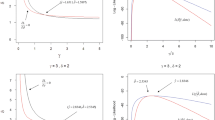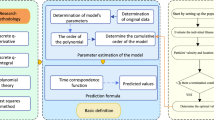Abstract
Getting accurate results when GM (1, 1) model is used for fitting and predicting approximate non-homogeneous exponential sequence, is a challenge. We sought to address this issue by combining Grey Theory and Credibility Theory, to develop a fuzzy GM (1, 1) model (FGM), which introduces the double exponential fuzzy numbers and its membership function. The expectation of fuzzy variables for replacing the non-homogeneous exponential sequence was calculated by Credibility Theory, i.e. the homogeneous process. The novel method yields unbiased results when used in fitting and predicting the tight non-homogeneous exponential sequence. Finally, we use an empirical case and a numerical sequence case to illustrate the effectiveness, feasibility, and optimization of the FGM (1, 1) model.
Similar content being viewed by others
Explore related subjects
Discover the latest articles, news and stories from top researchers in related subjects.References
Deng, J.L.: Control problems of grey systems. Syst. Control Lett. 1, 288–294 (1982)
Liu, S.F., Dang, Y.G., Fang, Z.G.: Grey System Theory and Its Application. Science Press, Beijing (2004)
Zeng, B., Meng, W., Tong, M.: A self-adaptive intelligence grey predictive model with alterable structure and its application. Eng. Appl. Artif. Intell. 50, 236–244 (2016)
Mao, Y., Tu, Y., Yang, H.: A new method to eliminate negative frequency interference based on wavelet transformation and grey correlation theory. In: Intelligent Control and Automation. pp. 4356–4361 (2012).
Liu, J.F., Liu, S.F., Fang, Z.G., et al.: New strengthening buffer operators based on adjustable intensity and their applications. J. Grey Syst. 26(3), 117–125 (2014)
Hsu, Y.T., Liu, M.C., Yeh, J., et al.: Forecasting the turning time of stock market based on Markov-fourier grey model. Exper Syst. Appl. 36, 8597–8603 (2009)
Wang, R.Q., Wang, F.X., Ji, W.T.: Particle swarm optimization based gm(11) method on short-term electricity price forecasting with predicted error improvement. Appl. Mech. Mater. 40, 183–188 (2011)
Peng, G., Wang, H., Song, X., et al.: Intelligent management of coal stockpiles using improved grey spontaneous combustion forecasting models. Energy 132, 269–279 (2017)
Liu, E., Wang, Q., Ge, X., et al.: Dynamic discrete GM (1, 1) model and its application in the prediction of urbanization conflict events. Discrete Dyn. Nat. Soc. 1, 1–10 (2016)
Dang, Y.C., Liu, S.F., Chen, K.: The GM models that x(n) be taken as initial value. Kvbernetes 33, 247–254 (2004)
Wang, Y.H., Dang, Y.G., Li, Y.Q.: An approach to increase prediction precision of GM(1,1) model based on optimization of the initial condition. Expert Syst. Appl. 37, 5640–5644 (2010)
Wang, Q.B., Jia, L.: Application of GM(1, 1) model based on residual error correction in athletic performance prediction. In: International Conference on Mechatronics, Materials, Chemistry and Computer Engineering. (2015).
Zeng, B., Feng, L.S.: Direct modeling approach of dgm(1,1) with approximate non-homogeneous exponential sequence. Syst. Eng. Theory Pract. 31, 297–301 (2011)
Li, S., Miao, Y., Li, G., et al.: A novel varistructure grey forecasting model with speed adaptation and its application. Math. Comput. Simul. 172, 45–70 (2020)
Li, S., Ma, X., Yang, C.: A novel structure-adaptive intelligent grey forecasting model with full-order time power terms and its application. Comput. Ind. Eng. 120, 53–67 (2018)
Zadeh, L.A.: Fuzzy sets. Inf. Control. 8, 338–353 (1965)
Kaufmann, A., Bonaert, A.P.: Introduction to the theory of fuzzy subsets-vol. 1: fundamental theoretical elements. IEEE Trans. Syst. Man Cybern. 7, 495–496 (1977)
Zadeh, L.A.: Fuzzy sets as a basis for a theory of possibility. Fuzzy Sets Syst. 1, 3–28 (1978)
Liu, B., Liu, Y.K.: Expected value of fuzzy variable and fuzzy expected value models. IEEE Trans. Fuzzy Syst. 10, 445–450 (2002)
Liu, B.D.: Uncertainty Theory: An Introduction to its Axiomatic Foundations. Springer, Berlin (2004)
Li X., Liu, B.D.: A sufficient and necessary condition for credibility measures. Int. J. Uncertainty Fuzziness Knowl. Based Syst. 14, 527–535 (2006)
Xue, F., Tang, W., Zhao, R.: The expected value of a function of a fuzzy variable with a continuous membership function. Comput. Math. Appl. 55, 1215–1224 (2008)
Reddy, G.T., Reddy, M.P.K., Lakshmanna, K., et al.: Hybrid genetic algorithm and a fuzzy logic classifier for heart disease diagnosis. Evol. Intell. 13, 185–196 (2020)
Asghar, M.Z., Subhan, F., Ahmad, H., et al.: Senti-eSystem: a sentiment-based eSystem-using hybridized fuzzy and deep neural network for measuring customer satisfaction. Softw. Pract. Exp. 51(3), 571–594 (2021)
Wang, Z.X., Dang, Y.G., Liu, S.F.: An optimal gm(1,1) based on the discrete function with exponential law. Syst. Eng. Theory Pract. 2, 61–67 (2008)
Acknowledgements
This work was supported by the Guangdong Province Philosophy and Social Sciences “Thirteenth Five-Year” Planning Discipline Co-construction Fund (no. GD17XGL02).
Author information
Authors and Affiliations
Corresponding author
Rights and permissions
About this article
Cite this article
Cao, L., Cao, X., Wang, Q. et al. Fuzzy Grey Model for Forecasting Non-homogeneous Exponential Sequence. Int. J. Fuzzy Syst. 24, 957–966 (2022). https://doi.org/10.1007/s40815-021-01179-7
Received:
Revised:
Accepted:
Published:
Issue Date:
DOI: https://doi.org/10.1007/s40815-021-01179-7




